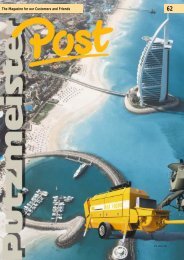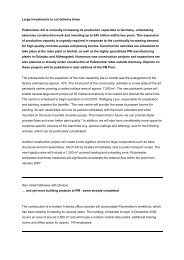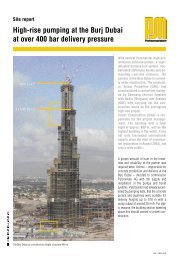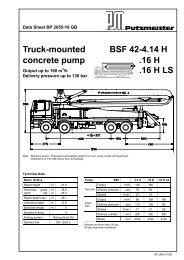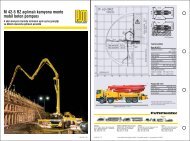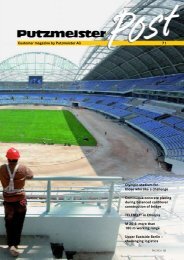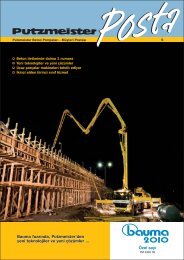2004 - Putzmeister
2004 - Putzmeister
2004 - Putzmeister
Create successful ePaper yourself
Turn your PDF publications into a flip-book with our unique Google optimized e-Paper software.
The Magazine for our Customers and Friends 58PM 3554 GB
2PM 3554 GBContentsLatest News4Academy1520 700 people trained in just four months 7VDMA sees precarious developments3 regarding steel pricesReady-mix concrete sectormeans to make good use of potentialsQuite another way of getting homeTitle storyEven in Afghanistan,4 you can always rely on <strong>Putzmeister</strong>Tunnel construction11 BSA concrete pumps in operation12 at 3 ICE tunnel construction sitesConcrete placement in the18 Hornberg Tunnel16 12InternationalEBC means easier site handling14 and less stress for the operatorEngineeringM 46-5 RZ:15 The latest addition to the 40-meter classBackground 14 19What is it that makes PM delivery hoses16 so robust and hard-wearing?Practical tipRubber hood provides protection from19 coupling3 45 62VDMA sees precarious developmentsregardingsteel pricesIn view of current price developments inthe steel market, the German EngineeringFederation (VDMA) sees the economicupswing endangered. The drastic increasein steel prices might trigger off a wave ofprice increases which would cause all ofthe business inflation rates to soar. Over aperiod of just six months, steel prices haverisen by up to 50 %, depending on the typeof steel.Further two-digit price increases have beenannounced by the steel industry for thissummer and the end of the spiral is not yetin sight. Market supplies are currentlyunreliable and it is not possible to calculateprice developments. According to estimatesmade by the Federation, in many cases,companies will be faced with two alternatives:either to turn down an order or to passon part of the price increase to the customer.<strong>Putzmeister</strong> AG has recorded considerableprice increases for structural steelworksince the beginning of this year. However,supply bottlenecks at many suppliers andrepeatedly postponed delivery dates areThe ready-mix concretesector means to makegood use of potentialsAccording to information given by theFederal Association for the German Ready-Mix Concrete Industry (BTB), the sectorhas set targets to increase its market sharein the long-term for the construction ofexternal walls. With an overall externalwall volume of around 64 million m 2 inresidential and non-residential buildingsin Germany (2003), concrete walls asformwork currently make up only around20 %. We are talking here mainly about theexternal walls of cellars and basements.The BTB therefore envisages a considerablepotential for ready-mix concrete inthe concreting of external walls. TheAssociation draws attention to, amongother properties, the excellent sound insulationfigures provided by concrete aswell as the possibility of manufacturingconstruction elements of concrete with“increased water penetration resistance”(water-tight concrete) for sites wherethere is pressing groundwater.likewise critical factors, affecting hydraulicpumps and hydraulic cylinders etc. Noteven the greatest efforts undertaken by PMPurchasing to make up for delayed deliveriesthrough overtime in the production, willprevent the consequences of the overallcritical situation impacting customers insome cases.According to experts’ estimations, futuredevelopment will be determined, on theWhilst most <strong>Putzmeister</strong> employees andtheir customers are content to make businesstrips using their own cars, or to takethe train or plane, Heinz Watzko (54)managing director of the BETONLIFTBetriebs GmbH Langenzersdorf (Vienna),demonstrates that there are yet other waysof getting home. At the end of May, he setoff from the PM works in Aichtal on hisconverted trekking bike equipped with3 x 9 gears, a comfortable saddle and allthe luggage he needed for his trip backhome to Gerhaus, around 45 kilometreseast of Vienna.The first challenges came along in the firststage of the tour when he reached theSwabian Alps and gradients of up to 17%.The rest of the tour will remain however inthe memory of the BETONLIFT’s sportsmanas one filled with beautiful landscapesand – up to 170 kilometers spent each dayin the saddle. The rest of the tour took himalong the banks of the Danube where everythingwent smoothly with neither puncturesnor broken wheel spokes to hold him up.Heinz Watzko cycled in all weathers: in8Latest Newsone hand, by the material requirements ofthe bulk purchaser markets and on theother hand, by in how far the capacity ofraw materials can be aligned with theserequirements. At the moment, there isnothing to show that general conditions forthe mechanical engineering sector areimproving. That means, there is only onething to do – all those affected must adaptto and make arrangements for this unusualsituation. In <strong>Putzmeister</strong> AG – a companyaware of its responsibilities – this willaffect internal procedures as well as longtermmaterial management planning.Therefore, any foresighted end consumer,i.e. the customer, will have to make arrangementsand prepare for the changed situation,as, on the one side, price increases formaterial will lead to supplementary chargesfor machinery and likewise for spares andwearing parts, and on the other side, longerdelivery times will mean that longerperiods must be taken into account wheninvestments are at the planning stage.Conclusion: The impacts of material shortageswill be felt both in the short as well asin the long term as longer delivery periodsrequire more long-term investment planningand higher prices for the machinesand wearing parts.It is therefore essential that all partnersaddress the matter and prepare themselvesfor the consequences it will bring.Quite another way of getting homeHeinz Watzko seen here just about to set off on his 875 kilometer toursunshine, thunderstorms, sleet and sometimesin temperatures of just 2-3°C. Aftercovering a distance of 875 kilometers, thesporty BETONLIFT manager arrived at hisdestination on the sixth day. Hats off to agreat achievement!3PM 3554 GB9
Title Story<strong>Putzmeister</strong> to the rescue –even in far-away Afghanistan1011A short time ago, the news that<strong>Putzmeister</strong> AG (PM) was about to havea truck-mounted concrete pump with a36 m boom transported out to Afghanistanreally caused a stir. Kabul was already alittle out of the ordinary as far as destinationsgo but air-freight as the means oftransport even more so. In a cloak-anddaggeroperation, the PM sales departmentundertook the task of getting a sparepart out to a customer in farawayHindukush for a machine that, althoughalready paid for, had not yet arrived withits rightful owner – due to “force majeur”.The Afghan customer FAZLULLAHCONSTRUCTION & ENGINEERINGCOMPANY (FCEC) was desperatelywaiting for the part after the machine hehad ordered had been kept back duringtransit by the neighbouring Pakistaniauthorities for more than five months.FCEC had been counting on getting thenew machine since autumn 2003 and thecompany’s books showed firm orders forprojects which were being financed withinternational aid (cf. PM-Post 56). As itbecame apparent that it was impossible tocomplete the jobs without the missing concretepump, <strong>Putzmeister</strong> AG readily agreedto cut out the red tape and take quickaction to help.Within a very short space of time,<strong>Putzmeister</strong> succeeds in finding not onlya suitable forwarder with contacts to airfreightcompanies but also in re-writing thenecessary shipping documents for a newM 36 which was to be sent suddenly to atotally different address.The key data for the transport are quicklyestablished and via an LH subsidiaryLUFTHANSA CARGO, a place for theM 36 is booked in a Ukranian ANTONOV124 transport plane leaving from HahnAirport in the Hunsrück and bound forKabul with a total of 79 tons on board. Inaddition to the truck-mounted concretepump, the freight consists of numerouspallets with medical aid from the RedCross and the Red Crescent as well asheavy fittings needed for the constructionof a water supply system for Kabul.1213 144PM 3554 GB5PM 3554 GB
Title StoryTruck-mounted concrete pump helpsto sell concreteIn Germany, we would describe theFAZLULLAH CONSTRUCTION &ENGINEERING COMPANY as a generalengineering company which also constructsturn-key projects. The company employsarchitects and construction engineers andcraftsmen representing practically all typesof work found in the construction business:bricklayers, concrete workers, plasterer,carpenters, electricians, glaziers, plumbers,painters etc. In the past six months, thenumber of permanently employed staff hasincreased from 100 to 200 and, dependingon the order books, more than 1,000persons are employed on a temporarybasis.Mr Tarshi, the owner of FCEC also participatesin a concrete mixing unit and a plantfor producing light-weight concrete hollowblocks, a plant he operates together with aTurkish partner TEPE. The mixing unitproduces on average around 2,500 m 3 ofconcrete – at peak times up to 6,000 m 3 amonth. The new M 36 is urgently neededas FAZLULLAH CONSTRUCTION wantto market its concrete via the pump service.Unskilled workers are paid $ 3 a day atFCEC, skilled workers receive $ 10 a day.Mr Tarshi, the company’s owner, looksafter his employees like a caring patronFCEC also operates a concrete works a few kilometres away from Kabul in cooperation with the Turkish company, TEPEarranging bus transport from their homes tothe construction site and providing themwith food during the day at no charge.Apparently, business has been good thelast two years, during which FCEC hascompleted more than 40 projects. Any newturn-key building completed is guarded byFAZLULLAH CONSTRUCTION ownpersonnel until it has been officially handedover to the owner. Some of the large-scaleprojects included several buildings for theISAF peace-keeping forces and the Afghanarmy, hospitals, schools, rehabilitationcentres, training facilities for teachers,radio and TV studios for the Ministry ofEducation etc. and numerous orders arewaiting for the next months.medical studies for five years. Now theyare making up for the lost time by attendinguniversity six days a week from 8 inthe morning until 1 in the afternoon afterwhich they deal with the office work atFAZLULLAH CONSTRUCTION. Theirearnings contribute decisively to supportingtheir parents and brothers and sisters.20 2221The city and its peopleKabul lies in a wide-spread valley at analtitude of about 1,800 m. A bird’s eyeview shows the city to be a totally driedup,grey and dusty. The streets however arepopulated by numerous pedlars and craftsmenand are in contrast, very colourful.It has not rained here for 5 years. Thesupply of drinking water depends mainlyon the snowfall in the surroundingmountains and from the volume of waterfrom the melting snow. Fifteen years ago,about 900,000 people lived in Kabul, thefigure today is estimated at three to fourmillion. The capital of Afghanistan hasnever known a comprehensive sewersystem. Power cuts are common and someareas do not have electricity. Any shopownerwho can afford it sees that he getshold of a petrol-driven emergency generator.The supply of drinking water also variesfrom place to place. Some streets aresupplied by a public network, in others thepeople have to fill up buckets with waterpumped by hand from a well. But you canalso see large trucks laden with water tanksfrom which the truck drivers sell drinkingwater to households.The bank system is still not functioning somost payments are made in cash, usually inUS dollar. The rate of exchange to theAfghani, the local currency, has fallendistinctly in the past months – a sign thatTitle Story24On the streets of Kabul, traditional “outfits” meet up with the new25A carpet salesman in front of his business premises26 27A chat with two students who were given ahalf-day job by Mr Tarshi reveals a glimpseof the difficulties of everyday life inAfghanistan. The two students are sisters intheir mid-twenties. During the Talibanregime, they were forced to break off theirThese two lady-students work in the FCEC officeshalf-days23Gholam Rasoul Tarshi and his managing directorHamid Dost seen here in front of a hospital built upagain by FCEC out of the ruins8PM 3554 GBThis new building complex built by FCEC is a centre of further education for teachersThere is no shortage of everyday consumer goodsAnd nothing is ever thrown away: This bike mechanichas given many a two-wheeler a new lease of life withused rims, forks and chain rings9PM 3554 GB
TitelstoryTitle Storythe Afghan economy is beginning tostabilize. The present rate is 1 : 50. As acomparison, a litre of diesel is sold for15 Afghani, and a litre of super costs24 Afghani.Busses, trucks and even cars often originatefrom the Seventies and Eighties and thesecond-hand spare parts business isflourishing. Any new parts coming in are inthe main via Pakistan. If they are availablethere, a delivery time of about a week isneeded. Not one internationally reputedtruck manufacturer has built up a supplyBusses from the Seventies can still be seen providing areliable service28system for its own spares in Afghanistan orKabul, let alone setting up a branch here.Most of the main roads are asphalted, butare often in a very bad condition. In themuddy side streets, vehicles are forced todrive at snail’s pace because of the numerouspotholes. There are no traffic regulations,or, if there are, they are ignored byeveryone using the roads.You can only telephone from a mobilephone as there is no conventional telephonenetwork. Most of the other towns inAfghanistan can be reached via mobilefrom Kabul. However, people living invillages are completely cut off from thismethod of communication – there are noconverters in the countryside. The onlyconceivable connection to the outsideworld could be by means of very expensivesatellite phones.After twenty years of war and civil war,huge areas of Kabul are destroyed – aroundthe former Royal Palace, there’s hardly onestone left standing on another. Other partsof town show signs of damage which isnow being cleared away. The inhabitants’talent for improvisation is remarkable. Inthe meantime, there are the first signs ofreconstruction: at the side of the roads,wooden struts are being offered to supportSigns of a country on the move: The carcass of a multi-storey residential and office block. In the foreground, the ceilingformwork of another new building is supported by wooden stakes.roofs and self-made wheelbarrows forgetting rid of rubble. When the next foundationslab is cast, then the new M 36 atFAZLULLAH CONSTRUCTION will betaking part in re-building Kabul.30 32Thorough on-site trainingVolker Schneider from <strong>Putzmeister</strong> AfterSales & Parts Service (APS) arrived inKabul just a few days after the truck-mountedconcrete pump. His task was to instructthe machine operators in the Afghan capital.A one-week training in the safe handlingand operation of the M 36 had beenpreviously arranged with FAZLULLAHCONSTRUCTION for two FCEC employees.These two operators will then go on toinstruct other colleagues later.Training began in the first two days withmock operations carried out on the premisesof the concrete works. These includedoutrigging the machine, lifting andunfolding the boom, changing the boomangle by remote control, smooth handlingof the end hose over the ground, cleaningthe pump and delivery lines – all theseoperations were practised until perfect –but without concrete! These instructionswere followed up by practical tips for lookingafter the machine and help in detectingthe causes of breakdowns. Not until thethird day, did concrete come into it. Twentycubic meters of concrete were then pumpedfor a building being constructed for theGreek ISAF unit. Nothing would stop theyoung soldiers from giving a helping handwith the end hose of the M 36 at the“maiden” performance of the concrete pump.He will be taking over the new M 36 from FCEC afterbeing given instruction by the PM service engineer(Photo: F. Abassi)Volker Schneider has no problems whatsoeverdealing with all the different mentalitieshe comes up against during his manyassignments abroad. In his own words,“There is an overwhelming interest ininformation concerning the concrete pumpengineering and both the friendliness andthe hospitality of the people I meet neverfail to impress me!”3329 31A few days before, PM service technicianhad been travelling around Jordan. A partof his mission included instructing machineoperators in the use of their new concretepump and training workshop personnel and<strong>Putzmeister</strong> representatives on site. On theside, Volker Schneider also passes on usefultips regarding preventive maintenancefor the machines and even helps out withtrouble-shooting on the construction site.The first cubic meters of concrete are pumped in viewof a highly interested audience (Photo: F. Abassi)34In some parts of Kabul, destruction caused by the civil war is still highly visible10PM 3554 GBThe formwork for the piers are ready.All that’s needed now are the pumps!Nothing will stop the Greek ISAF soldiers from giving a helping hand with the end hose (Photo: F. Abassi)11PM 3554 GB
Tunnel construction11 BSA concrete pumps in operationat 3 ICE tunnel construction sites37Tunnel construction38Work is progressing well on the “RoadProject German Unity No. 8” betweenNuremberg and Munich. The projectinvolves an extension of the express railconnection (ABS) from Munich to Ingolstadt(82 km) as well as the 89 km Intercityexpress route (NBS) from Nuremberg toIngolstadt. On the 15.6 km long contractsection Centre, up to 11 stationary<strong>Putzmeister</strong> BSA concrete pumps aresimultaneously in operation.35part run parallel to the A9 motorway.Of all the contract sections, the Los Mitteespecially features many tunnel constructionsites. This section is approximately18 kilometers long and is being built by theHOCHTIEF company. It consists of threelong tunnels totalling 15.6 kilometers inlength: the Irlahüll Tunnel (7,260 m), theSchellenberg Tunnel (650 m) and theEulerwang Tunnel (7,700 m) plus the constructionof 13 emergency exits with around8,000 access galleries, some of which aretrafficable. The tunnel construction worksare being carried out by the ARGE TunnelLos Mitte HOCHTIEF/ALPINEBAU(Deutschland).The NBS Nuremberg-Ingolstadt tunnelshave an excavated cross-section of around140 m 2 and were driven with crown andbench using the drill and blast method. Thetunnel tubes are built to accommodate dualtracks and a direct or indirect emergencyexit is accessible every 1000 m along thedistance of the tunnel. The special geologicalconditions (including cavities in thekarst rock being tunnelled) of the IrlahüllTunnel required in some sections additionaldrift walls with follow-up crown and benchas well as tube protection measures duringdriving work under A9 Motorway wherethe overlying ground was just 10 metersthick.Complex concrete internal shellThe tunnel is a double-walled constructionconsisting of a 25 to 35 cm thick shotcreteouter shell reinforced with concrete steelmesh and a 35 to 50 cm thick interior shellof cast-in-place concrete. In between thetwo shells is a sealing foil. The vault of thetunnel is divided up into 12 m long blocksin each of which approximately 200 m 3concrete is placed.The concrete for the Los Mitte section ismade in three mixer units, using concreteformulations for the mixes based on acombination of Portland cement and flyash. ARGE decided to use an additivecombination of polycarboxylatether (a newOne of the 11 BSA’s placing concrete in a cross tunnel in the Irlahüll Tunnel12PM 3554 GBGraphic showing the route of the new Intercity expresslink between Nuremberg and Munich (Graphics: DBProjektbau)The new high-speed section will connectBerlin with the Bavarian capital via Halle/Leipzig and Erfurt from 2006. The 171 kmrail track between Nuremberg and Municharound the NBS section is designed forspeeds up to 300 km the hour and willreduce travelling time between the twocities from 102 to just 64 minutes.In order to avoid carving up the landscapeany further, the new 89 km ICE track fromNuremberg to Ingolstadt will for the mostSome of the BSA concrete pumps are 400 metersaway from the placement site36generation of plasticizing admixtures) andan air-entraining agent to obtain and maintainthe targeted workability.Depending on the application, the cementcontents are between 320 and 240 kg/m 3 .The German Federal Bureau of Railwaysapproved each single case for all of theconcrete formulations.The tunnel vault in the Los Mitte section isconstructed using formwork transportwagons each equipped with two attachedwagons for secondary re-working.The humidity in a standing layer of air inthese secondary wagons can be kept at ahigh level. This guarantees optimal hydrationin the concrete layer near to the surface.Furthermore, the layer of air acts asheat insulation and thus protects the concretefrom temperature shock which couldlead to cracking.Enormous quantities of concreterequiredARGE Tunnel Los Mitte deployed up toten stationary PM BSA 1408 E concretepumps and one BSA 1005 D for concretingthe different sections of formwork. Themachines are needed to pump enormousquantities of concrete for the inverts(totalling approx. 262,000 m 3 ) and vaults(totalling approx. 231,000 m 3 ) at the sametime into several places at once in the threetunnels, including the emergency andconnecting galleries. In addition, around157,000 m 3 concrete have to be transportedfor other filling in work. The concrete ispumped through type 125 delivery lines,some of which are 400 m long and handleuphill grades of up to 10 %.Directly on site if necessary: PMCustomer Services and wearing partsRoland Ebner, machine foreman at ARGETunnel Los Mitte is obviously more thansatisfied with the reliability of the BSApumps and the customer service which ison call whenever needed. “Nothing is takenfor granted regarding the concrete pumpseven when we do take care to see that themachines are regularly serviced. We takeon the lubricating service of course ourselves– for other tasks, we are helped onrequest by the <strong>Putzmeister</strong> branch inMunich (Eching). That holds good too forall the usual customer service intervals aswell as for prompt delivery of spares suchas spectacle wear plates and wear rings.When we order today, the parts areguaranteed to be on the construction sitethe following day!“Machine foreman Roland Ebner looks pleased aboutthe excellent cooperation with the PM branch inMunich3913PM 3554 GB
InternationalErgonic Boom Control means easier site handling40and less stressfor the operatorJean-Michel Gérini can remember the firsttime he used his new M 36 Z pump verywell. Operating conditions in the narrowalleyways in Toulon were particularlycramped, with hardly room for outriggingthe machine. But the coffee – served inthe early morning on the edge of the constructionsite on a silver tray – couldn’thave tasted better. That’s what we call style!Six months have passed since then and thenew BSF 36.14 H belonging to TRANS-PORT ET POMPAGE DU LITTORAL(T.P.L.) has pumped more than 5,000 m 3 ofconcrete in about 70 operating hours withoutany cause for complaint. In the meantime,the <strong>Putzmeister</strong> M 36 has become theflagship of the T.P.L. fleet and is operatedpersonally by junior manager Jean-MichelGérini (34) himself who has been managingthe family business since <strong>2004</strong>.The machine features all of the comprehensivebasic equipment as well as several usefulextras; e.g. a vibrator in the feed hopperwhich prevents particularly stiff concretebatches from building up on the grid. Thetwo additional tanks in the rear supportlegs are also special extras. They can eachhold around 250 l of water and dieselwhich means the truck-mounted concreteCoffee is served at the edge of the excavation pit!pump is not dependent on a supply ofcleaning water and fuel when used on siteover longer periods of time. Jean-MichelGérini decided on the EBC as it providesconsiderably easier operation on the onehand, and, on the other, benefits his customers– the site personnel as the man on theend hose is often no longer required forplacing concrete if the placing boom isequipped with EBC and the operator canbe deployed for other tasks.The T.L.P. fleet comprises 8 truck-mountedconcrete pumps and 20 truck mixers. Notincluded are several veteran concrete pumpswhich have also found a place in the depot.They originate from the Seventies and forthe company’s founder, their conveyingsystems represent engineering history whichhe finds difficult to give up. T.P.L. employa total workforce of 33.The registered headquarters of TRANS-PORT ET POMPAGE DU LITTORAL are41in the east part of Toulon. The company’scatchment area comprises the Mediterraneancoast between Marseille and Nice andextends deep into the hinterland of themaritime Alps. The T.L.P. services for concretepumps and truck mixers work closelytogether with a neighbouring concreteworks and its interests are aimed more atnumerous small and medium-sized orderswhich their own operations planning cantake care of, rather than large-scale constructionsites. The company calculateswith a lump sum for each deployment plusthe price for the cubic meters of concretepumped, which varies depending on thesize of the boom.This flat tray prevents concrete from soiling the roadunder the pump hopper when concrete is transferredfrom the truck mixer4243The latest addition to the 40-meter classThe new extremely compact version ofthe truck-mounted concrete pump M 46-5met with lively interest at the BAUMA.A longer version is also available asM 47-5. When designing the big “Fives”,<strong>Putzmeister</strong> attached the greatest importanceto several aspects:■ short overall length, thereforeparticularly manoeuvrable in roadtraffic and on site■ no boom overhang■ smallest possible support widthand minimal area requirements viadiagonal supports■ flexible boom folding in alignmentwith site conditions.The concept of the modern M 46 / M 47“Fives” was confirmed by a distinctlypositive response from customers both athome and abroad. For example, the overalllength of the M 46-5 is less than 12 meterswhich allows the machine to be used inseveral European countries without havingto obtain a special permit. Besides fulfillinglegal requirements, the short constructionlength has other distinct benefits, e.g.regarding manoeuvrability on narrow,twisting country roads or when operated inlow mountain ranges or in the Alps. Thecompact design is also advantageous ininner-city traffic. This plus in manoeuvrabilityis also supported by the short wheelbase (*) of 6.1 meters (a 5.7 m version isalso available for operation in Switzerland)and an arm assembly which does notproject to the rear or over the front of thevehicle dimensions.Other advantages become convincing whenthe machine is in operation on the constructionsite. The small support groundarea and the narrow support widths areboth equally amazing. When fully supported,the <strong>Putzmeister</strong> M 46-5 / M 47-5 needsjust 8.0 m to the front and 8.9 m to therear. In one-sided support mode (OSS), themachine stands safely for operation on just5.1 m (6.6 m).The larger version M 47-5 has a boomincorporating the same kinematics as theM 46-5, whereby only the last arm hasbeen extended by one meter.In future issues of the PM Post, we will bereporting on the large “Fives” in the 40-mclass under these aspects. ConstructionEngineeringjournals will also be introducing the<strong>Putzmeister</strong> M 46-5 series – either in sitereports or – as can be seen below – inadvertisements.(*) The wheel base given refers to thedistance between the first front axle andthe first rear axle.Der Kompakte mit der großenReichweite: M 46-5 RZDer neue M 46-5 RZ ist dank Diagonalabstützungund OSS (Einseitiger Schmalabstützung) enormschnell und auf kleinster Fläche aufgestellt.So wird die große Reichweite des flexiblen5-Arm-Mastes optimal ausgenutzt.Kompakt und sicher ist er auch im Straßenverkehr:aufgebaut auf 4-Achs-Standardchassis ohne Überhangmit einer Gesamtlänge unter 12 m.Bei OSS (Einseitige Schmalabstützung)vorne nur 5,1 m44Work on site is simplified by the flexiblefive boom arms and an optimised boomfolding system – whether concrete forfloor slabs for cellars is being placedor ceilings in high-rise buildings orintroducing the end hose into narrowwall formwork.2674Für mehr Informationen fragen Sie uns.Selbst bei Vollabstützung vorne nur 8,0 m<strong>Putzmeister</strong> AG · Max-Eyth-Str. 10 · D-72631 AichtalTel. +49 (71 27) 599-0 · Fax 599-520 · www.putzmeister.de14PM 3554 GBFully outrigged even in the most cramped conditionsThe diagonal supports of the M 36 need very littlespace – here, a narrow gateway is more than enough
BackgroundBackgroundWhat is it that makesPM delivery hoses so robust?They come up against some pretty roughhandling – the high-pressure deliveryhoses on concrete pumps. The followingreport illustrates just how much knowhowgoes into the development andmanufacturing of these flexible deliverylines.The PM spares sales department has a widerange of high pressure-proof delivery hoseswith inside diameters from 32 to 200 mm(1 1/4” to 8”) and lengths of up to 40 m inone piece. The standard version is permittedfor use with operating pressures of upto 85 bar. They are tested up to 170 bar ata prescribed safety factor of 2 (Employer’sLiability Insurance Association and/orDIN/EN 12001). The actual bursting pressureat which they are finally destroyed ishowever often considerably higher. In orderto compensate for any fluctuations in production,the hoses are designed to withstandconsiderably higher rupture pressuresso that e.g. 65-type hoses from the series asa rule can withstand 200 bar and more. Thequality of this major accessory is constantlyinspected in cooperation with PM suppliersto optimise the manufacturing of requiredmaterials and to constantly improve thewear behaviour of the end product.Complex manufacturing processSeen purely from the outside, a deliveryline would appear to be made just of rubberwith metallic push-and-fit connections atthe end. Inside however, is considerablymore complex. Around the central core(inside hose) made of 6 – 7 mm rubbermaterial, a fine steel wire mesh is plaited.The thickness of the plaiting and thenumber of individual steel wires dependson the permissible operating pressure – inan extreme case, up to six wire layers areembedded in the hose. As a rule, a 2.5 mmhose cover is sprayed on as the outsidelayer to protect the hose form externaldamage.In the next two production steps, the blankhose is armoured and vulcanised in aspecial-purpose boiler, whereby the rubbermaterial is actually baked on to the multilayersteel wire mesh at temperatures of160 to 170 °C for about 20 minutes.46No kinks, please!All concrete delivery hoses supplied by<strong>Putzmeister</strong> AG are marked with themanufacturer’s key number, the date ofproduction, the permissible operatingpressure, the safety factor and informationregarding the nominal width. That means incases of damage, any claims for recoursecan be settled and material defects betraced – something which happens veryrarely. The quota for complaints is lessthan 1%. More often than not, damage canbe put down to improper handling of theconcrete delivery hoses, e.g. from pumpingthrough bent hoses. The larger the permissiblebending radius, the more frequentlysuch kinks occur. Other damage is causedby friction on the outer rubber layer e.g.from pulling and dragging the hoses oversharp edges and reinforcements. This leadsto the inner steel layers being exposed andthe bare wires begin to corrode andobviously, in turn, impacts the compressionstrength and the end of the story is aruptured hose.PM delivery hoses are available withvarious types of flange connections. Theycan be connected tailor-made to one of thethree <strong>Putzmeister</strong> coupling systems (SK,ZX or PX). In order to avoid bumps whenthe delivery hose is flanged – and thus therisk of blockage – this area of the insidewall of PM hoses is stripped and providestherefore a smooth and flush fit.By the way, it is technically no problemto make the delivery hoses for higherpumping pressures of 85 bar. For example,in the mining industry, delivery hoses fortransporting rapidly-setting mortars areapproved for use at operating pressuresof up to 160 bar. Bursting pressure: in thiscase, 420 bar.This is how the raw rubber is delivered –here is an approximately 50 x 30 x 20 cmbail from Indonesia474849How to recognize topgradedelivery hoses1. Double safety factorAt 85 bar operating pressure this meansthe delivery hoses will not rupture untilpressure is over 170 bar. Any lowersafety factors for delivery hoses are onthe one hand not permissible and on theother hand, they quickly become permanentlydamaged for example, whenblocked up and then burst under normaloperating conditions.2. Hardened nozzlesThe best hose is worth nothing if it isfitted with a cheap nozzle. Nozzlehardness of at least 60 HRC Rockwellmeans you need not throw away a goodand still usable hose just because thenozzle has worn out.3. Stripped hosesThis allows a better fitting of the nozzleto the inside diameter of the deliveryhose. This is not only important for theservice life but especially in the case ofthe type 65 hoses for pump behaviourbecause only when the inner wall of thehose has been stripped, does the wholeof the delivery line have the same interiordiameter.4. Bending radiusThe smaller the bending radius, themore resistant the hose is to kinks.Plaited hoses in particular have theedge over wound hoses, which areonly suitable for larger diameters.16PM 3554 GBA fine network of steel wires is plaited by machine around the central core of the hoseThe 2.5 mm thick hose covering is then sprayed on to the steel wire mesh.The delivery hose is then marked.45The rubber used for the delivery hoses is aparticularly abrasion-proof and weatherproofmix based on natural rubber.Compared with synthetic rubber, thismaterial displays considerably better wearbehaviour. By adding various filling agentssuch as soot and sulphur, it is possible tohave targeted influence on the properties ofthe delivery hoses. But any “ideal” rubberformulation will always demand compromisesto be made: as in practice, thefrequently required “improved hardness”of the rubber material results in a distinctincrease in rigidity and this in turn impactsthe handling of the delivery hose.Nevertheless. PM concrete delivery hosesare made according to three different formulationsdepending on the varying requirementsof the customers and the field ofapplication.Racks of delivery hoses waiting to be transported to PM high-bay warehousesAfter the inner wall has been stripped, the nozzle isinserted and compressed to the delivery hose505. Thickness of wearing layer andthe hose coverThe less room required by the wires,the more room there is inside and outsidefor the usable i.e. wearable rubberlayer. The steel wire layer in hoseswith plaited fabric is less thick, due tothe mode of manufacturing. The overallstrength of the hose covering doesnot always say very much about itsquality, although it often provides anindication.6. Other factorsFor concrete pump operators, it is oftenmore difficult to measure values whichhave considerable effect on the quality.These include friction values for rubber,nozzle hardness penetration (at PM0.7 mm) and vacuum stability. All areconstantly tested during production.Any serious hose manufacturer will alsomake regular random inspections atshort intervals in which delivery hosesare subjected to extreme pressures untilthey finally burst.17PM 3554 GB
18PM 3554 GBTunnel constructionConcrete placement inthe Hornberg TunnelThe most important section of the Hornbergby-pass is currently under constructionin the form of a dual-lane highwaytunnel almost 2 kilometers in length. Therelocation of the B 33 main road is partof the project and as a traffic calmingmeasure will make a considerable contributionto the Black Forest community.Two PM truck-mounted concrete pumpsequipped with 24 meter booms that can beoperated in tunnels are in use almostevery day, after the tunnel excavation hadbeen secured using a <strong>Putzmeister</strong> wetshotcrete machine.The project is being executed by the constructioncompanies STRABAG andKIRCHNER who have formed a joint ventureunder the name of ArbeitsgemeinschaftTunnel Hornberg (ATH). The work hasbeen commissioned by the Federal Republicof Germany.ARGE began blasting the approximately1,850 m long highway tunnel in March2002. After creating the first crowns andbenches, the rest of the tunnel was drivenas a full face with a typical cross section ofabout 85 m 2 . The first 400 meters weresecured with dry shotcrete but after that,the ARGE thought it necessary to changeover to wet shotcrete because of theirregular rock formation and the presenceof open seams. These jobs were carried outusing a <strong>Putzmeister</strong> shotcrete manipulatorof the type WETKRET WKM 103. Thisspray gun handled about 6,500 m 3 ofconcrete over a distance of almost 1.5kilometers in just ten months to form a10 – 15 cm thick exterior shell.The real interior shell is divided up into191 sections, the length of each blockbeing typically 10 m. The wall thicknessvaries – depending on the geological conditions– between 30 and 60 cm. The projectmanagement calculates approximately100 to 120 m 3 of concrete for one blockand a placement time of about 4 hours inone go. In all, around 21,000 m 3 concreteare required for the interior shell of theHornberg Tunnel. This concrete is of typeB 25 to which has been added a wettingagent and a flowing agent. Particle size atthe connection to the banquette is 0/16 mm,otherwise 0/32 mm.First, the dry shotcrete, and some of thewet shotcrete, was stored in large silos onsite. As work progressed, all of the concreterequired for the construction was deliveredas ready-mix by UHL TransportbetonGmbH.UHL is a medium-sized company situatedjust a few kilometres away in Hausach. Thecompany operates several quarries as wellas concrete and gravel works and has itsown pump service, using 7 truck-mountedpumps in the 20, 30 and 40 meter class.So on the tunnel construction site, twomachines from the UHL fleet can often beseen placing concrete for the interior shellin parallel over the ten concrete supportsfor each block.The BSF 24.11 H truck-mounted concretepump is equipped with a four-sectioned,Z-roll folding placement boom with a largeboom angle which requires a mere 4.9 meterheight for unfolding. This means that placementbooms of this type are more or lesspre-destined for concreting in underpasses,halls or, as here, in tunnels.All the latest safety standards are beingobserved during the construction work onthe Hornberg Tunnel. For example, oncompletion there will be 5 emergency exitsas well as two lay-bys for vehicles whichhave broken down. The total length of theescape tunnels alone is 850 meters.Additionally, along two thirds of the lengthof the tubes in the roof, a concrete intermediateceiling has been built which functionsas an independent means of ventilation oras a fumes outlet in the event of fire. Theintermediate ceiling is concreted after thevault formwork has been placed using aM 24 truck-mounted concrete pump andspecial-purpose manoeuvrable formworkwagon in 10 meter long sections. Thecompletion of the carcass work for theHornberg Tunnel is scheduled for the endof September <strong>2004</strong>.The M 24-4 with its multi-Z boom fold is ideally suited for placing concrete beneath low hall ceilings and tunnels.Placing concrete on the vault formwork in the Hornberg Tunnel.5152Rubber hood provides protection from couplingDuring the BAUMA trade fair, lots ofinteresting accessories for truck-mountedconcrete pumps were on display at the<strong>Putzmeister</strong> booth. Among them was theprotective hood shown on the right which,in many cases, simplifies the work of theoperator and at the same time provideseffective protection for the man workingwith the end hose.The protective hood fulfils two requirements:First, it respects the fact that it isprohibited to attach extension couplings ornozzles to the end hose – a fact stated inany operating manual for truck-mountedconcrete pumps. The reason is the greatrisk of injury presented by these metalparts – the end hose operator holds them atbody height – when, e.g. the boom shouldswing uncontrolled (something which canhappen if there are blockages, or air in theconcrete delivery line, or an operating errorin the boom control etc.).The protective hood also makes allowancesfor everyday activities on the constructionsite because, in practice, from time to timeit is necessary to extend the boom deliveryline by attaching additional hoses. As longas the placement boom is not additionallyRotor pumps superstrengthconcreteEven if the application of high-strengthand super high-strength concrete iscurrently restricted to just a few specialpurposeconstruction projects, the significanceof this extremely robust materialwill increase in the near future. Concretesof approximately 250 N/mm 2 are alreadybeing placed today and under laboratoryconditions, even a super high-strengthconcrete of 800 N/mm 2 has been produced.These special concrete formulations relysignificantly on a homogenous andthorough mixing process and an extremelylow water content.In time-consuming and costly investigations,it was successfully proven that rotorconcrete pumps are very well suited forconveying super high-strength concretecontaining < 1% air-entraining agent undervacuum. The starting point was the manufacturingof super high-strength concreteconstruction elements for a pre-fabricatedjob in which the conveyance of 15 m 3 /hsuper high-strength concrete was testedusing a rotor pump.loaded and the boom tip is stable, there isno reason to worry about safety, as far asthe manufacturer is concerned. In order tobe able to connect up the line extension“on the quick”, many operators have replacedthe nozzle-free end hose of theirtruck-mounted concrete pump with a4 meter long delivery hose with a connectingflange. We would like to expresslypoint out that a freely hanging and unprotecteddelivery hose on the boom tipis a clear breach of clearly defined safetyregulations!The <strong>Putzmeister</strong> “protective hood solution”in comparison divides up the usual 4 meterend hose into a 2-meter delivery hose(fixed to the boom tip) and a short 2 meterend hose. Both hoses are connected with acoupling over which the relatively softrubber protective hood can be pushed. Thiseffectively protects the end hose operatorfrom injuries and the pump operator hasless weight to drag along when connectingan additional delivery line. Now, he needno longer take the heavy 4-meter end hosefrom the boom tip but just the short2-meter piece underneath the protectivehood.The tests confirmed that using a correctlydesigned concrete pump, further air entrainmentcan be avoided so that the mechanicalproperties of the super high-strength concreteare further improved. Furthermore,preference should be given to using a hosepump as this allows the delivery line to bemore or less completely emptied, especiallywhen producing concrete pre-fabricatedparts. As super high-strength concrete containsspecial-purpose fine particles and chemicaladditives, being able to completelyempty the delivery line also brings noticeablefinancial benefits. These results wereobtained from joint investigations made byPractical tipThe short delivery hose (top) is connected to the real endhose (2 meters in length) at a height of 2 meters. Theprotective hood over the coupling protects site personnelfrom injury.the Maschinenfabrik Gustav Eirich GmbH& Co. KG, the Technical University Munich,the University of Leipzig, the Max BöglBauunternehmung GmbH & Co. KG and<strong>Putzmeister</strong> AG.Note: The tests were made using a rotorpump in order to benefit from the financialadvantages which the total emptying of thedelivery line brings. In future, transportingsuper high-strength concrete to great heights,e.g. when building high-rise residential andoffice buildings, the first choice will remainwith BSA concrete pumps which are designedfor high pressure conveyance.535419PM 3554 GB
AcademyTraining for 700 peoplein just four monthsAt the end of April, the PM-Akademiewelcomed Radivoje Jovašević as its 700thtrainee of <strong>2004</strong>. The 24-year old head ofCustomer Services works at <strong>Putzmeister</strong>’sbranch in Belgrade D.S. INZENJERING(DSI) and was taking part in an intensive,4-day training for technicians togetherwith workshop leaders from 17 countries.In several countries of the formerYugoslavia, he supports numerous concretepump veterans and more and more,new PM pumps, too.In the meantime, the <strong>Putzmeister</strong> Akademieis offering this course of internationalservice training at regular intervals. It isprimarily targeted at improving servicequality and at informing Customer Servicestaff about the latest developments inhydraulic and electronic control systemsfor PM machinery.Imprint:Publisher<strong>Putzmeister</strong> AGMax-Eyth-Str. 10 · D-72631 AichtalTel. +49 (71 27) 599-0 · Fax 599-520Internet: http://www.putzmeister.deE-mail: pmw@pmw.de■ Editor: Jürgen Kronenberg■ Design: Friedrich Pippichin 1971) mounted on a FAP. DS keeps manyof the required wearing parts and spares instock for many of the veterans – if somethingis missing, it can be ordered from thePM After Sales & Parts Service in Aichtal.In the meantime, the number of concretepumps in the constituent states of formerYugoslavia increasingly includes new machines.For example, the two BSF 36.14 H<strong>Putzmeister</strong> AG, Max-Eyth-Str. 10, D-72631 AichtalPSdg, Deutsche Post AG, Entgelt bezahlt, E 60458in Belgrade and Skopje, the BSA 1407 Dand a BSA 1408 E have contributed to“rejuvenating the population” of concretepumps in this part of the Balkans. Themachines are primarily used in renovationjobs, in extensions to the infrastructure andfor placing concrete in private constructionprojects. The operators can always counton having an experienced Customer Serviceat hand for service jobs.55Service for both old and new concretepumpsD.S.INZENJERING has a workforce of tenwho are responsible for looking after about70 <strong>Putzmeister</strong> vehicle-mounted and trailermountedpumps in Serbia, the SrebskaRepublic, Montenegro and Macedonia. Theowners of the machinery are often operatorsof concrete works who offer an additionalpump service for the concrete delivery. Theoldest of these machines is a truck-mountedconcrete pump with a 20 m boom (builtYour fax for further information■ Would you like more information on certain topics in this edition of <strong>Putzmeister</strong> Post?If so, just copy this page, make a cross next to the topics you are interested in and faxthe form to us. We will then send you detailed information immediately.❏ Truck-mounted concrete pump M 36-4 „Z“ ........................................BP 3180❏ Stationary concrete pumps ..................................................................BP 2632❏ Truck-mounted concrete pump M 46-5 „RZ“ ......................................BP 3552❏ <strong>Putzmeister</strong> delivery line systems ......................................................PM 2300❏ Truck-mounted concrete pump M 24-4 ..............................................MT 1085❏ Concrete spraying system SIKA-PM 500 (replacement for WETKRET) ..TS 3573❏ Rotor-PUMI ® ........................................................................BP 2047, BP 3536Name .........................................................................................................Company ...................................................................................................Position .....................................................................................................Street .........................................................................................................Post Code/City ..........................................................................................Tel. No. ......................................................................................................E-mail ........................................................................................................<strong>Putzmeister</strong> AGMax-Eyth-Str. 10 · D-72631 AichtalP.O.Box 21 52 · D-72629 AichtalTel. +49 (71 27) 599-0Fax +49 (71 27) 599-520Internet: http://www.putzmeister.deE-mail: pmw@pmw.dePM 3554 GBAll rights reserved. Subject to technical amendments without notice. The illustrations in some cases show special-purpose machine designs and snapshots of sitepractice which do not always comply with the regulations determined by professional bodies.© <strong>2004</strong> by <strong>Putzmeister</strong> Printed in Germany (20407 RR)



![Data sheet BSA 1005 D SV (TB 2206) [.pdf; 459.58 kb] - Putzmeister](https://img.yumpu.com/51174022/1/184x260/data-sheet-bsa-1005-d-sv-tb-2206-pdf-45958-kb-putzmeister.jpg?quality=85)
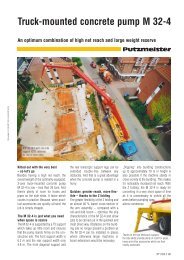
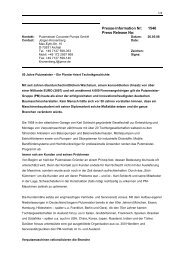
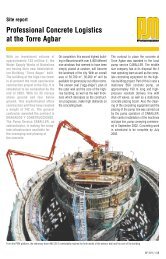
![Typenblatt CS 3095 [.pdf; 202.40 kb] - Putzmeister](https://img.yumpu.com/50530164/1/184x260/typenblatt-cs-3095-pdf-20240-kb-putzmeister.jpg?quality=85)
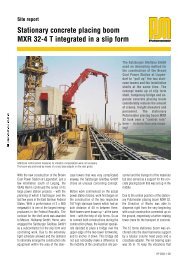
![M 47 Broşürü [.pdf; 527.92 kb] - Putzmeister](https://img.yumpu.com/49631771/1/190x141/m-47-brosuru-pdf-52792-kb-putzmeister.jpg?quality=85)
